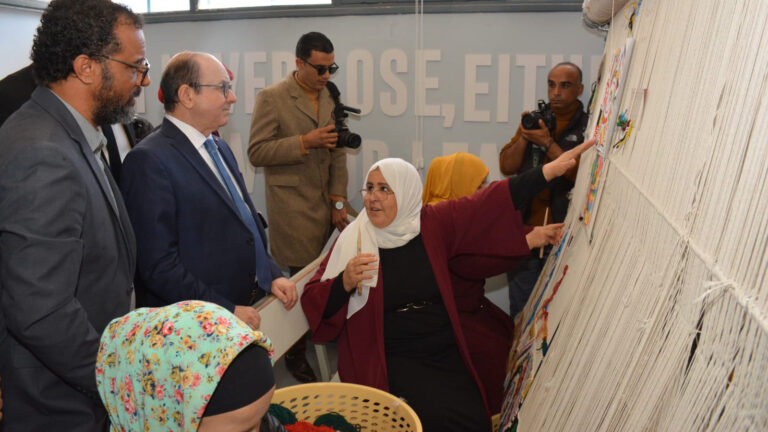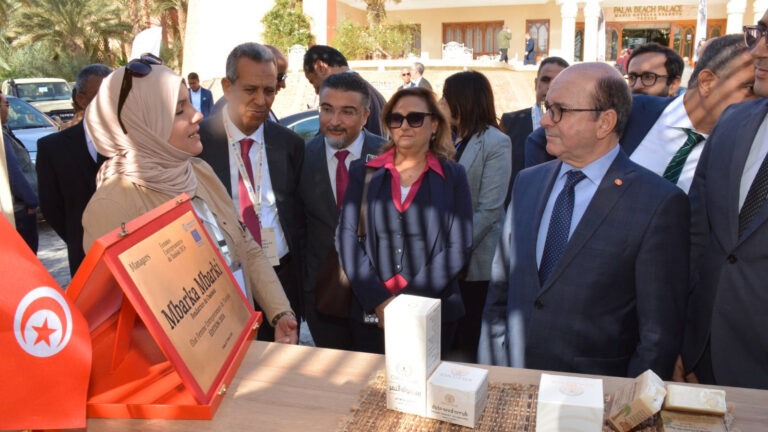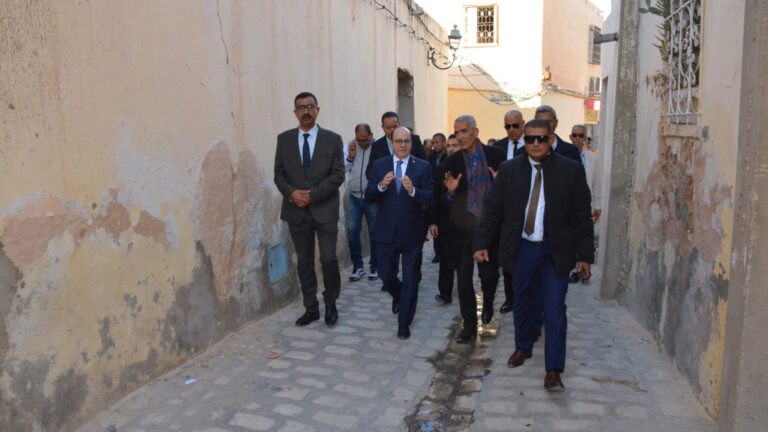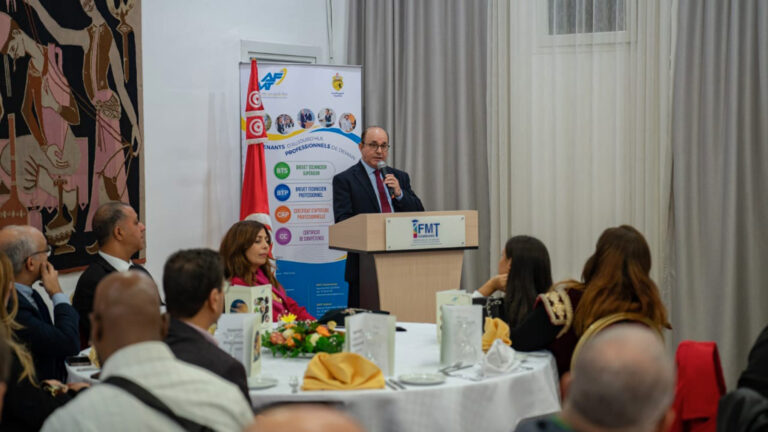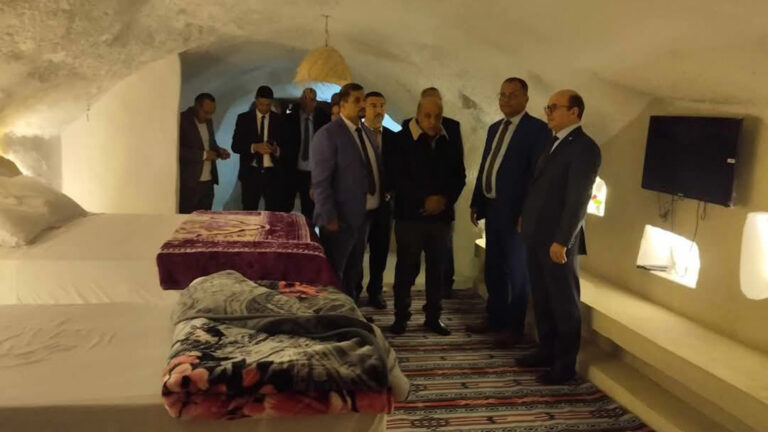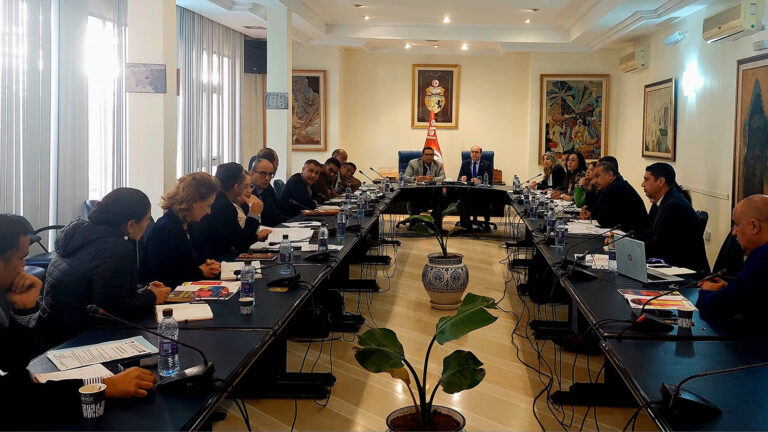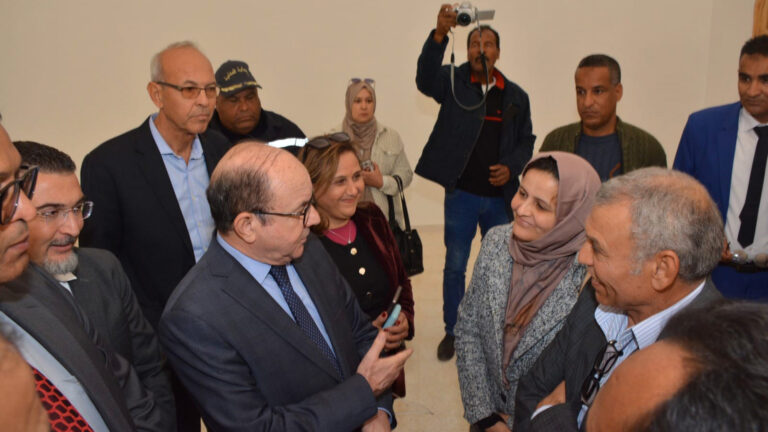- الوزارة
- السياحة
التكوين والمهن السياحية
السياحة والترفيه السياحي
الاستثمار
الدراسات والإحصائيات
- المؤشرات الرئيسية
- التوجهات الاستراتيجية
الإطار القانوني
البرامج والمشاريع والصناديق
السياحة
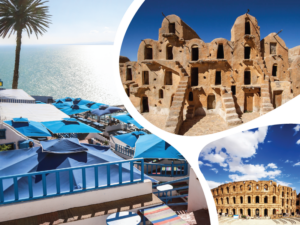
يشهد قطاع السياحة التونسية انتعاشة غير مسبوقة سنة 2025، متجاوزا أكثر التوقعات تفاؤلا بحيث نأمل في استهداف 11 ملايين زائر
- الصناعات التقليدية
القرى الحرفية
التكوين المهني
- التكوين والشهادات المتاحة للحرفيين
- المدارس ومراكز التكوين المتخصصة والمعتمدة
- مهن الحرف اليدوي
الأرقام والإحصائيات
- لمحة عن القطاع
- الأرقام الرئيسية
- التوجهات الاستراتيجية
- المشاريع والبرامج
الإطار القانوني
- النصوص القانونية المنظمة للقطاع
- حقوق وواجبات الحرفيين
- معايير الجودة و المصادقة على المنتجات
الصناعات التقليدية

تشكل الصناعات التقليدية أحد أكثر القطاعات ديناميكية في الاقتصاد التونسي حيث تساهم بنسبة 4٪ من الناتج المحلي الإجمالي.
- المستجدات
- اتصال
البرنامج
Programme de Mise à Niveau des établissements Hôteliers
Cadre général / contexte
Le Tourisme : Un secteur clé de l’économie tunisienne
Le tourisme constitue un pilier de l’économie tunisienne, contribuant à concurrence de 4,5% du PIB et employant directement ou indirectement près de 400.000 personnes. Les revenus actuels de ce secteur totalisent près de 5628 millions de dinars et couvrent environ 35% du déficit commercial national.
La Tunisie compte à l’heure actuelle, 876 unités hôtelières avec une capacité d’hébergement de 236 mille lits, cette infrastructure hôtelière est soutenue par l’existence de 1354 agences de voyages, 374 restaurants touristiques, 07 parcours de golf, …
La Tunisie représente une destination privilégiée et importante du bassin méditerranéen enregistrant environ 9,4 millions d’arrivées de touristes étrangers et plus de 30 millions de nuitées hôtelières. Le marché européen demeure avec plus de 64% des nuitées et 64% des recettes le client le plus important des unités hôtelières avec la France, l’Allemagne, l’Italie et le Royaume-Uni, comme principaux pays émetteurs.
La Tunisie bénéficie aussi d’un tourisme de voisinage très intense puisqu’il contribue à hauteur d’environ 52% des arrivées aux frontières mais avec uniquement 12,3% des nuitées et 30,7% des recettes, par ailleurs le tourisme domestique est jugé encore en deçà des espérances, et ne représentent que 19% des nuitées hôtelières globales.
- Cadre général
Le Tourisme : Un secteur clé de l’économie tunisienne
- Avantages accordés
Des incitations financières à la mise à niveau
- Procédures
- Décret n° 2009-2100 du 30 juin 2009
- le COPIL
- Tableau de bord
Le Tourisme : Un secteur clé de l’économie tunisienne
برنامج تأهيل المؤسسات الفندقية
البرنامج
برنامج تأهيل المؤسسات الفندقية
الإطار العام
يعتبر قطاع السياحة في تونس من القطاعات الاقتصادية الاستراتيجية ورافدا أساسيا من روافد التنمية في البلاد، باعتبار مكانته في الاقتصاد الوطني ودوره الهام في دفع التنمية الشاملة والمساهمة الفعالة في العديد من القطاعات والأنشطة الاقتصادية الأخرى حيث تبلغ مساهمته في الناتج المحلي الإجمالي حوالي 10٪ كما يساهم في تشغيل قرابة 400 ألف شخص بشكل مباشر وغير مباشر. وقد حضي القطاع الفندقي كإحدى أهمّ مكوّنات القطاع السياحي بأهمية بالغة وذلك عبر إقرار برنامج لتأهيل المؤسسات الفندقية الذي يندرج في إطار إستراتيجية النهوض بالقطاع السياحي التونسي في أفق 2035.
هو مبادرة أطلقتها الدولة التونسية سنة 2005 من خلال برنامج نموذجي شمل 45 وحدة فندقية بطاقة إيواء تقدر ب 20 ألف سرير قصد:
- تحسين القدرة التنافسية وتحقيق مردودية أفضل للقطاع.
- تحسين قدرة القطاع على مجابهة أزمات الظرف الاقتصادي العالمي.
- معالجة مشكل المديونية الذي تعاني منه جل الوحدات السياحية بما يضمن إعادة التوازن المالي للقطاع البنكي.
- تدعيم الوجهة التونسية كأحد أعرق الأقطاب السياحية في ضفاف المتوسط من خلال الانصهار في منظومة الجودة وتأهيل الكفاءات.
وقد تم تعميم البرنامج سنة 2007 ليشمل كل المؤسسات الفندقية المصنفة دون استثناء .
يهدف برنامج تأهيل المؤسسات الفندقية خاصة إلى دعم الاستثمارات اللامادية المتمثّلة أساسا في انصهار المؤسسات الفندقية في البرامج الوطنية للجودة والاندماج في المنظومة الوطنية للتكوين وتعميم استعمال تكنولوجيات الاتصال الحديثة في النزل وإعادة الهيكلة المالية وحماية المحيط الداخلي والخارجي للمنشآت الفندقية والانخراط في البرنامج الوطني للتحكم في الطاقة والمياه وتركيز نظام اليقظة الإستراتيجية.
ينصهر برنامج التأهيل في إطار إستراتيجية تنمية قطاع السياحة، من أجل ذلك وقع إقرار جملة من المحاور الإستراتيجية ذات الأولوية لتجسيم هذه الإستراتيجية والتي يجب أن يتضمنها كل مخطط لتأهيل المؤسسة الفندقية. وتشتمل المحاور الإستراتيجية ذات الأولوية على ما يلي :
- الانصهار في البرامج الوطنية للجودة وحماية المحيط
- الاندماج في المنظومة الوطنية للتكوين
- تعميم استعمال تكنولوجيات الاتصال الحديثة في النزل
- إعادة الهيكلة المالية
- الانخراط في البرنامج الوطني للتحكم في الطاقة والمياه
- تركيز نظام اليقظة الإستراتيجية
- تطوير مؤسسات الدعم وإعادة النظر في الإطار القانوني والترتيبي
- القانون عدد 90 لسنة 2004 المؤرخ في 31 ديسمبر 2004 والمتعلق بقانون المالية لسنة 2005 وخاصة الفصلين 33 و 34 منه.
- الأمر عدد 2123 لسنة 2005 المؤرخ في 27 جويلية 2005 والمتعلق بتنظيم وزارة السياحة وخاصة الفصل عدد 12 منه والمتعلق بضبط مشمولات مكتب تأهيل المؤسسات الفندقية.
- الأمر عدد 2100 لسنة 2009 المؤرخ في 30 جوان 2009 والمتعلق بضبط شروط وإجراءات إسناد المنح الخاصة ببرنامج تأهيل المؤسسات الفندقية وهيكلة تمويل الإستثمارات التي تخول الانتفاع ﺑﻫﺫه المنح وخاصة الفصلين 4 و 5 منه والقاضيين بإحداث وتركيبة ومشمولات لجنة قيادة برنامج تأهيل المؤسسات الفندقية.
برنامج تأهيل المؤسسات الفندقية
الإطار الترتيبي
أحدث مكتب التأهيل السياحي بمقتضى الأمر عدد 2123 لسنة 2005 المؤرخ في 27 جويلية 2005 والمتعلق بتنظيم وزارة السياحة وخاصة الفصل عدد 12 منه والمتعلق بضبط مشمولات مكتب تأهيل المؤسسات الفندقية.
تطبيقا لذلك، فهو مكلف خاصة بإعداد ومتابعة الملفات الخاصة ببرامج التأهيل الخاصة بكل وحدة وعرضها على أنظار لجنة قيادة البرنامج وبمساعدة الباعثين على تمويل بعض عناصر برامج التأهيل عبر تشخيص الآليات التي تمكن من تمويل هذه العناصر إضافة إلى كتابة لجنة قيادة برنامج التأهيل.
أحدثت لجنة قيادة برنامج تأهيل المؤسسات السياحية بمقتضى الأمر عدد 2100 لسنة 2009 المؤرخ في 30 جوان 2009 والمتعلق بضبط شروط وإجراءات إسناد المنح الخاصة ببرنامج تأهيل المؤسسات الفندقية وهيكلة تمويل الإستثمارات التي تخول الانتفاع ﺑﻫﺫه المنح وتأسيا بذلك فهي مكلفة بالنظر في ملفات برامج التأهيل الخاصة بكل مؤسسة فندقية وإقتراح إسناد المنح الخاصة ببرنامج التأهيل المنصوص عليها بالأمر المشار إليه أعلاه.
وتتركب لجنة قيادة برنامج تأهيل المؤسسات الفندقية والتي يترأسها وزير السياحة أو من ينوبه والمنصوص عليها بالفصل 5 من الأمر المشار إليه أعلاه من :
- ممثل عن وزارة المالية
- ممثل عن وزارة التنمية والتعاون الدولي
- ممثل عن وزارة التربية والتكوين
- ممثل عن وزارة البيئة والتنمية المستديمة
- 4 ممثلين عن الجامعة التونسية للنزل
- ممثل عن الجامعة التونسية لوكالات الأسفار و السياحة
- البنك المركزي التونسي
- البنك التونسي الكويتي
- الجمعية التونسية للمستثمرين في رأس المال
- الشركة التونسية للبنك
- البنك التونسي
برنامج تأهيل المؤسسات الفندقية
الآليات
يتضمن برنامج تأهيل المؤسسات الفندقية قسمين:
- منحة للاستثمار وأخرى لتمويل دراسات التأهيل، تهدفان إلى دعم أصحاب النزل في تحديث وتطوير مؤسساتهم، وتشجيعهم على الاستعانة بالخبراء والمستشارين لضمان حسن تنفيذ الإجراءات المطلوبة.
- دراسة بعنوان "التشخيص ومخطط التأهيل"، تهدف إلى تحليل وضعية المؤسسة الفندقية ضمن بيئتها الداخلية والخارجية، وتحديد نقاط قوتها وضعفها، واقتراح الإجراءات المناسبة لتحسين أدائها وتعزيز قدرتها التنافسية.
في إطار تحسين جودة الخدمات الفندقية والتشجيع على الاستثمارات اللامادية ضمن برنامج التأهيل السياحي، تم اتخاذ إجراءات جديدة خلال المجلس الوزاري المضيق المنعقد بتاريخ 29 جوان 2009 من أهمها وضع آلية التدابير اللامادية ذات الأولوية التي تمكن المؤسسات الفندقية من الاستفادة من عدة امتيازات وبإجراءات ميسرة.
حيث تمكن آلية التدابير اللامادية ذات الأولوية من معالجة ثلاث إشكاليات رئيسية التي تعيق تنفيذ برنامج تأهيل المؤسسات الفندقية، وهي:
- نقص الاستثمار اللامادي: وذلك بسبب نظام المنح الذي يعتبر غير محفز للاستثمار في الجوانب اللامادية؛
- طول الإجراءات: حيث يمكن للمؤسسات الفندقية إنجاز الاستثمارات اللامادية والاستفادة من امتيازات صندوق تنمية القدرة التنافسية في قطاع السياحة FODEC-T، دون المرور بإجراءات الحصول على الموافقة المبدئية من قبل لجنة القيادة في مرحلة أولى، ثم المصادقة على مخطط التأهيل في مرحلة ثانية؛
- صعوبة توفير الموارد الضرورية لتمويل استثمارات التأهيل: حيث يمكن للمؤسسات الفندقية إنجاز استثمارات اللامادية دون تقديم مخطط استثمار مصحوب بهيكل تمويل موافق عليه من قبل البنك.
Insérer titre de la bannière ici
Lorem ipsum dolor sit amet, consectetur adipiscing elit, sed do eiusmod tempor incididunt ut labore et dolore magna aliqua. Ut enim ad minim veniam, quis nostrud exercitation ullamco laboris nisi ut aliquip ex ea commodo consequat. Duis aute irure dolor
Titre du Noeud (Tourisme/Artisanat)
Titre intégral (long) de la page
What is Lorem Ipsum?
Lorem Ipsum is simply dummy text of the printing and typesetting industry. Lorem Ipsum has been the industry’s standard dummy text ever since the 1500s, when an unknown printer took a galley of type and scrambled it to make a type specimen book. It has survived not only five centuries, but also the leap into electronic typesetting, remaining essentially unchanged. It was popularised in the 1960s with the release of Letraset sheets containing Lorem Ipsum passages, and more recently with desktop publishing software like Aldus PageMaker including versions of Lorem Ipsum.
Why do we use it?
It is a long established fact that a reader will be distracted by the readable content of a page when looking at its layout. The point of using Lorem Ipsum is that it has a more-or-less normal distribution of letters, as opposed to using ‘Content here, content here’, making it look like readable English. Many desktop publishing packages and web page editors now use Lorem Ipsum as their default model text, and a search for ‘lorem ipsum’ will uncover many web sites still in their infancy. Various versions have evolved over the years, sometimes by accident, sometimes on purpose (injected humour and the like).
Where does it come from?
Contrary to popular belief, Lorem Ipsum is not simply random text. It has roots in a piece of classical Latin literature from 45 BC, making it over 2000 years old. Richard McClintock, a Latin professor at Hampden-Sydney College in Virginia, looked up one of the more obscure Latin words, consectetur, from a Lorem Ipsum passage, and going through the cites of the word in classical literature, discovered the undoubtable source. Lorem Ipsum comes from sections 1.10.32 and 1.10.33 of “de Finibus Bonorum et Malorum” (The Extremes of Good and Evil) by Cicero, written in 45 BC. This book is a treatise on the theory of ethics, very popular during the Renaissance. The first line of Lorem Ipsum, “Lorem ipsum dolor sit amet..”, comes from a line in section 1.10.32.
The standard chunk of Lorem Ipsum used since the 1500s is reproduced below for those interested. Sections 1.10.32 and 1.10.33 from “de Finibus Bonorum et Malorum” by Cicero are also reproduced in their exact original form, accompanied by English versions from the 1914 translation by H. Rackham.
Where can I get some?
There are many variations of passages of Lorem Ipsum available, but the majority have suffered alteration in some form, by injected humour, or randomised words which don’t look even slightly believable. If you are going to use a passage of Lorem Ipsum, you need to be sure there isn’t anything embarrassing hidden in the middle of text. All the Lorem Ipsum generators on the Internet tend to repeat predefined chunks as necessary, making this the first true generator on the Internet. It uses a dictionary of over 200 Latin words, combined with a handful of model sentence structures, to generate Lorem Ipsum which looks reasonable. The generated Lorem Ipsum is therefore always free from repetition, injected humour, or non-characteristic words etc.
Téléchargements
Documents à télécharger
Lorem ipsum dolor sit amet, consectetur adipiscing elit, sed do eiusmod tempor incididunt ut labore et dolore magna aliqua
- Cahier des charges de l'étude
- Fiche d'adhésion au PMNH
- Fiche actions PMNH
- Fiche de candidature AIP
- Fiche actions AIP
